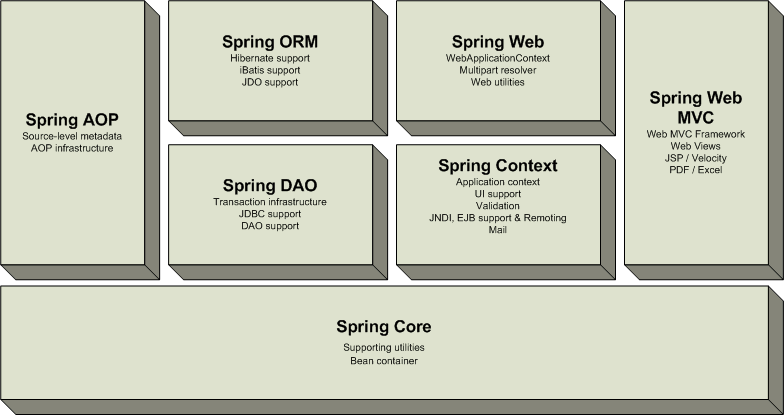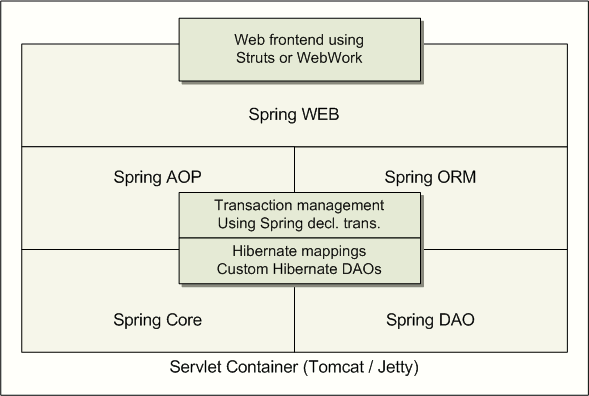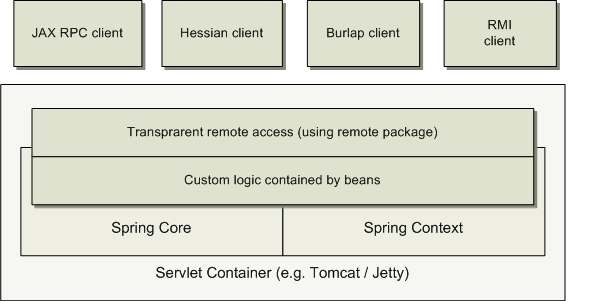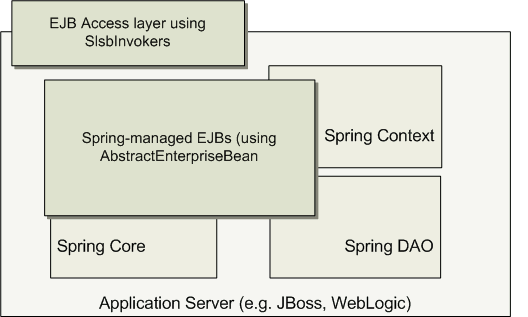Spring contains a lot of functionality and features, which are well-organized in seven modules shown in the diagram below. This section discusses each the of modules in turn.

Overview of the the Spring Framework
The Core package is the most fundamental part of the framework and provides the Dependency Injection features allowing you to manage bean container functionality. The basic concept here is the BeanFactory, which provides a factory pattern removing the need for programmatic singletons and allowing you to decouple the configuration and specification of dependencies from your actual program logic.
On top of the Core package sits the Context package, providing a way to access beans in a framework-style manner, somewhat resembling a JNDI-registry. The context package inherits its features from the beans package and adds support for text messaging using e.g. resource bundles, event-propagation, resource-loading and transparent creation of contexts by, for example, a servlet container.
The DAO package provides a JDBC-abstraction layer that removes the need to do tedious JDBC coding and parsing of database-vendor specific error codes. Also, the JDBC package provides a way to do programmatic as well as declarative transaction management, not only for classes implementing special interfaces, but for all your POJOs (plain old java objects).
The ORM package provides integration layers for popular object-relational mapping APIs, including JDO, Hibernate and iBatis. Using the ORM package you can use all those O/R-mappers in combination with all the other features Spring offers, like simple declarative transaction management mentioned before.
Spring's AOP package provides an AOP Alliance compliant aspect-oriented programming implementation allowing you to define, for example, method-interceptors and pointcuts to cleanly decouple code implementing functionality that should logically speaking be separated. Using source-level metadata functionality you can incorporate all kinds of behavioral information into your code, a little like .NET attributes.
Spring's Web package provides basic web-oriented integration features, such as multipart functionality, initialization of contexts using servlet listeners and a web-oriented application context. When using Spring together with WebWork or Struts, this is the package to integrate with.
Spring's Web MVC package provides a Model-View-Controller implementation for web-applications. Spring's MVC implementation is not just any implementation, it provides a clean separation between domain model code and web forms and allows you to use all the other features of the Spring Framework like validation.
With the building blocks described above you can use Spring in all sorts of scenarios, from applets up to fully-fledged enterprise applications using Spring's transaction management functionality and Web framework.

Typical full-fledged Spring web application
A typical web application using most of Spring's features. Using TransactionProxyFactoryBeans the web application is fully transactional, just as it would be when using container managed transaction as provided by Enterprise JavaBeans. All your custom business logic can be implemented using simple POJOs, managed by Spring's Dependency Injection container. Additional services such as sending email and validation, independent of the web layer enable you to choose where to execute validation rules. Spring's ORM support is integrated with Hibernate, JDO and iBatis. Using for example HibernateDaoSupport, you can re-use your existing Hibernate mappings. Form controllers seamlessly integrate the web-layer with the domain model, removing the need for ActionForms or other classes that transform HTTP parameters to values for your domain model.

Spring middle-tier using a third-party web framework
Sometimes the current circumstances do not allow you to completely switch to a different framework. Spring does not force you to use everything within it; it's not an all-or-nothing solution. Existing frontends using WebWork, Struts, Tapestry, or other UI frameworks can be integrated perfectly well with a Spring-based middle-tier, allowing you to use the transaction features that Spring offers. The only thing you need to do is wire up your business logic using an ApplicationContext and integrate your Web UI layer using a WebApplicationContext.

Remoting usage scenario
When you need to access existing code via webservices, you can use Spring's Hessian-, Burlap-, Rmi- or JaxRpcProxyFactory classes. Enabling remote access to existing application is all of a sudden not that hard anymore.

EJBs - Wrapping existing POJOs
Spring also provides an access layer and abstraction layer for Enterprise JavaBeans, enabling you to reuse your existing POJOs and wrap them in Stateless Session Beans, for use in scalable failsafe web applications, that might need declarative security.